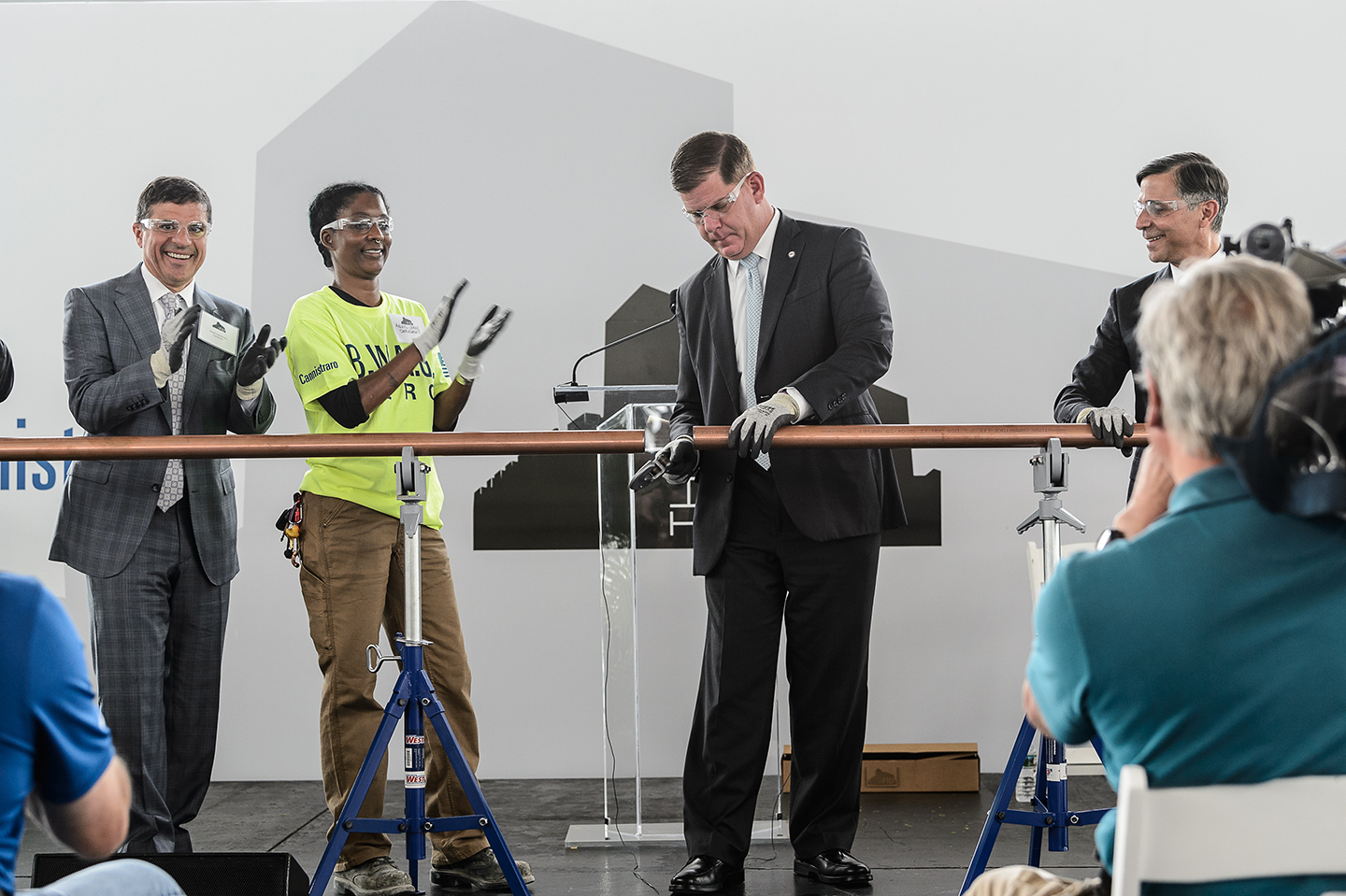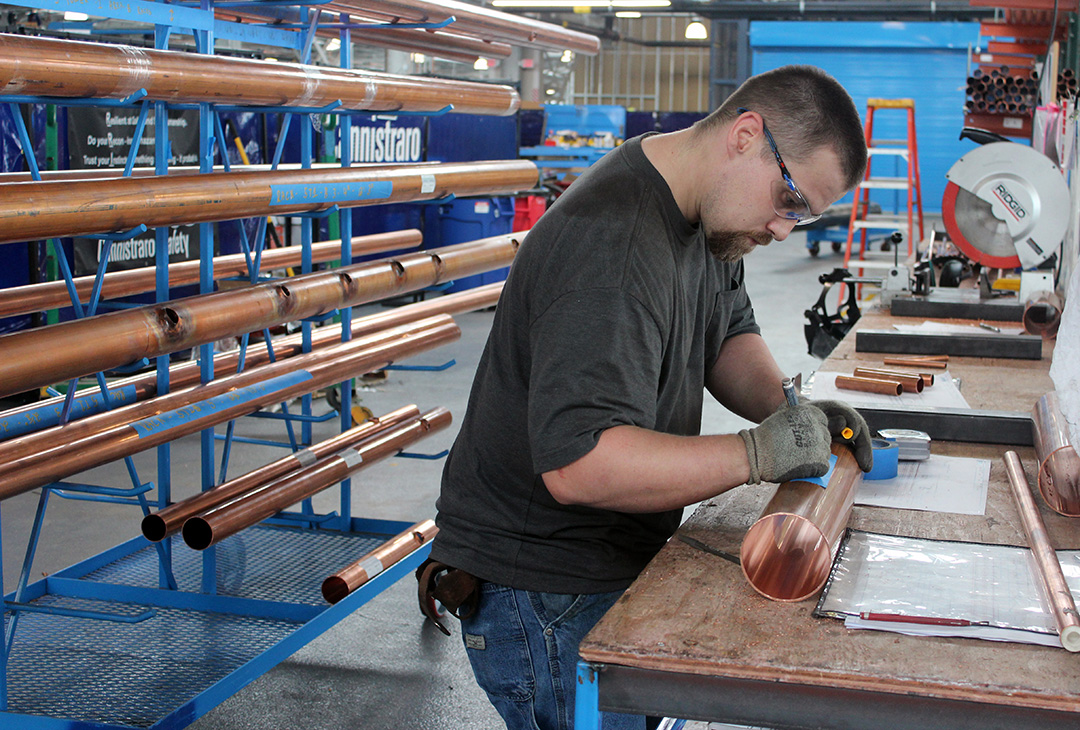Cannistraro Consolidates in Seaport

“Look,” says John Cannistraro, Jr., president of J.C. Cannistraro, as he waves his hand in a sweeping gesture across the massive production floor of the 157,000-square-foot building. “We can drive a tractor trailer through here on four ends.”
The building is The FID, which stands for “Fabrication, Industry, Design.” Officially opened in June, it is the new home for the company’s manufacturing and warehousing operations.
There is more to the name than its acronym. The building is located on Fid Kennedy Avenue in the Raymond L. Flynn Marine Park at the far end of Boston’s Seaport District. With the city’s construction development humming at a frenzied pace, The FID gives J.C. Cannistraro a prime downtown base in the epicenter of the activity. As to how the street got its name, it commemorates Thomas “Fid” Kennedy, a longshoreman and an uncle of President John F. Kennedy. A fid was a tool that longshoreman used to splice large rope.

Instead of cutting a ribbon, J.C. Cannistraro held a pipe-cutting ceremony to dedicate its new fabrication plant, The FID. Boston Mayor Martin J. Walsh had the honor of cutting the pipe.
Local 12 plumbers based in the building are prefabricating mechanical systems and assemblies for J.C. Cannistraro’s many projects. The multi-trade shop is also producing fire protection, sheet metal, and HVAC piping systems at The FID.
Throughout the bright, open, and airy building, mechanics are busy at workstations crafting systems. Many carts are filled with piping that has been cut to various lengths. There are skids filled with shrink-wrapped, pre-assembled systems. Every palette, skid, cart, and system is labeled to identify its contents and its precise destination and, in true lean manufacturing style, is scheduled to be transported in short order for just-in-time delivery to job sites.
Nearly everything on the floor is modular and can be easily moved and reconfigured to accommodate new projects of any size. Cannistraro says that his team is constantly striving to maximize the flexible workspace by improving workflows and processes.
To move items between the building’s two floors, there are two large freight elevators at either end. In the building’s center, there is a 25-foot-long hoist that can load and unload material directly from and into a trailer using an overhead crane.

The FID includes a computer-controlled automatic pipe cutter, but employees deburr pipes by hand.
Previously, J.C. Cannistraro operated three prefabrication plants at three different sites: one at its Watertown headquarters and two at leased spaces in Wilmington and Stoughton. With the leases expiring and a desire to consolidate operations under one roof, the company began looking for a new location. The property in the Seaport emerged on the radar.
The U.S. Navy erected the enormous building in 1940 as a multi-trade machine shop to support the country’s WWII efforts. “Nothing had been done to it in over 75 years,” Cannistraro says about the property. It had been sitting idle for about three decades and was ready for the wrecking ball. “Everything was in disrepair. It was a rust bucket,” he adds.
Yet, the J.C. Cannistraro management team loved the location, recognized the building’s good bones and its potential, and presented a lease proposal to the city. “When we said that we wanted to keep the building, the city responded, ‘Are you kidding?’ ” says Cannistraro with a laugh.
The proposal outlined how the company would use the building and explained that it would employ union labor for a number of trades. That corresponded with Boston’s mission to bring industry and manufacturing jobs into the city. It also would repurpose the building for the 21st century and make it possible to resume the kind of work for which it was originally intended, notes Cannistraro. “That basically helped seal the deal.”
Over the course of 18 months, the entire building was gutted. Virtually nothing remains of the original structure except its exterior. It has been restored to its 1940 industrial Art Deco splendor, however.

Stunning wooden double doors recall The FID’s 1940 origins and make a great first impression.
Stunning, large, wooden double doors recall the era and make a great first impression. Vintage-style windows overlook Boston Harbor and the burgeoning Seaport District. In recognition of the restoration, the National Park Service has cited the building with a historical designation.
It may look period-appropriate, but the building boasts modern, green features. These include a stormwater recharging system, an exhaust recovery system for the welding stations, and highly efficient gas heaters to keep the huge building comfortable in the winter.
In addition to its striking form, The FID offers great function for J.C. Cannistraro. It is about 30% larger than the combined spaces of the former prefabrication shops. And, Cannistraro says, it is “20 times better.” With all of the work it is doing in Boston, especially in the Seaport, the location allows the company to save considerable time as well as fuel expenses transporting its prefabricated systems to job sites.
Looking to the future, Cannistraro says that the building is highly adaptable and will be able to meet the company’s evolving needs and handle its growth. He also says that The FID’s seaside location might offer more than compelling views of the harbor. Perched next to the Conley Terminal, in which Massport is investing hundreds of millions of dollars, the company could explore using barges to ship some of its oversized systems.
That would bring a smile to longshoreman Thomas “Fid” Kennedy.
